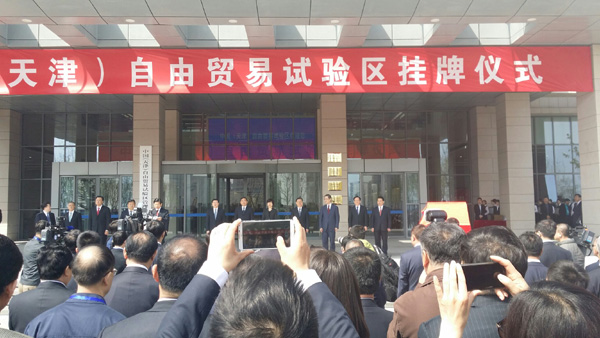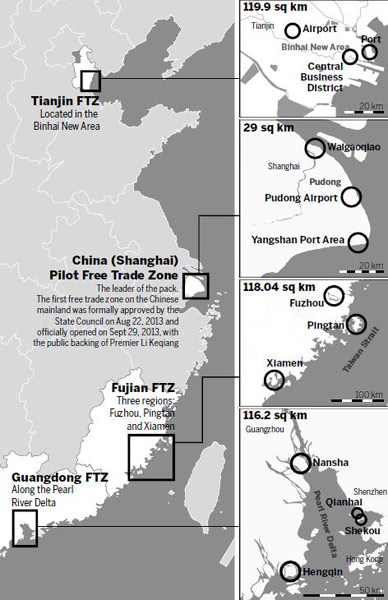- Search
-
Web.
 |
| China (Tianjin) Pilot Free Trade Zone is launched on April 21, 2015. |
BEIJING - Operations formally kicked off Tuesday at three new free trade zones (FTZ), as China opens itself wider to the outside world.
The three new zones come 18 months after the first FTZ was unveiled in the financial hub of Shanghai, which was designed to showcase efforts to streamline the overloaded administrative approval system and encourage innovation and internationalization.
Officials expect the three new FTZs -- in Tianjin, Guangdong and Fujian -- will boost economic reform, promote trade and facilitate investment in new areas, as the world's second largest economy moves away from its unsustainable export-dependent model.
Some businesses have already felt the efficiency of the new zones.
Liu Qiya, the chief financial official with Tuwei Tongli Electrical Technology based in Xiamen, an open coastal city of Fujian, said his company was granted an operational license for the zone just three days after the application was submitted. The same procedure in other parts of the province could take weeks.
According to a detailed plan released on Monday, the new zones will be based on the Shanghai FTZ but with a focus on the potential of their geographical locations.
By its first anniversary, the Shanghai zone had seen nearly 12,000 registered enterprises lured by a better trade and investment environment.
The Tianjin zone aims to better integrate the northern municipality with Beijing and Hebei province. It will prioritize modern service industries, including shipping, culture and equipment manufacturing.
The Guangdong zone will deepen economic cooperation between the mainland and the neighboring special administrative regions of Hong Kong and Macao.It will have three bases in the cities of Guangzhou, Shenzhen and Zhuhai.
The Fujian zone will focus on developing economic cooperation between the mainland and Taiwan. It will cover three areas in Xiamen, Fuzhou and Pingtan, a new industrial park targeting investment from Taiwan.
The Shanghai zone, which has been more than quadrupled in size since it was established, will continue to strive for "the greatest openness" to facilitate investment and trade with currency convertibility and a sound legal environment. It will also further open its service and manufacturing industries.
All zones must adhere to the negative list, which details 122 prohibited or restricted areas for foreign investment, ranging from Internet news service, production of radio and television programs to non-ferrous metal mining. This number has been reduced from 139.
Foreign investors will be subject to the same rules and regulations for new investment as domestic firms.
Experts believe that these fresh zones are strategically important for the "belt and road" initiative, which aims to better connect Asia, Europe and Africa, as a way to boost investment and consumption.
 |
Shao Yu, Shanghai-based chief economist of the Orient Securities Co,Ltd, said the four FTZs will be crucial "supporting points" for the belt and road initiative.
"More opening-up moves are needed in regions such as southwestern Yunnan and Tibet for the new strategic layout," he said.
Wang Shouwen, assistant minister of commerce, has said that the new zone will not just copy the Shanghai zone but also break fresh ground in areas such as the investment administration, trade regulation and financial systems.
The replication of successful reform measures is a common strategy in the reform and opening-up drive. The Shenzhen Special Economic Zone, founded in 1980, has been rolled out along the entire east coast over the past three decades.
That zone allowed foreign investment to develop the manufacturing industry, a driving force behind the economic boom of previous decades.
The FTZ fever has caught the attention of officials across the country, with many pushing for their regions to be included in the next batch of FTZs.
However, observers warned that the central government must ensure that the FTZs are used to pioneer reform measures, and that their policies are correctly implemented.
Dragged down by a housing downturn, softening domestic demand and unsteady exports, the once sizzling economy registered its lowest annual expansion in 24 years in 2014 and the weakness has continued into 2015.
Authorities have called for more opening-up policies to shore up development amid concerns of the slower growth, officially dubbed the "new normal."
Foreign business groups have said that the Shanghai zone brought improvements but they expected "more tangible benefits" of financial reforms, such as full convertibility of the yuan.
The China (Tianjin) Pilot Free Trade Zone will cover 119.9 sq km and consist of three parts:
1. The North Port Area of Tianjin Port (30 sq km)-It will focus on modern services such as air logistics, international trade, financing and leasing.
2. The Tianjin Airport Area (43.1 sq km)-It will focus on advanced manufacturing industries such as aviation, equipment of various kinds, next-generation information technology and producer services including research and development and design.
3. The central business district in the Binhai New Area (46.8 sq km)-It will focus on modern services such as financial innovation.
The China (Shanghai) Pilot Free Trade Zone will expand from 29 sq km to 120.72 sq km. It will encompass Pudong (the city's main business district), the Lujiazui financial district, the Qiantan area and two development districts.
It will incorporate and unify four existing bonded zones that focus on customs services, logistics and trade. The 34.26 sq km Lujiazui financial district is a national financial and trade hub.
Both Jinqiao development district (20.48 sq km) and Zhangjiang High-tech Park (37.2 sq km) are national-level industrial development districts focusing on high-tech manufacturing and research.
The Fujian FTZ will cover 118.04 sq km and consist of three regions:
The Pingtan (43 sq km) section, which will focus on building a "common home" for people across the Taiwan Straits and developing an international tourism island.
The Fuzhou (31 sq km) section, which aims to become a demonstration zone of cross-Straits service trade and financial innovation cooperation, will comprise the Fuzhou Economic and Technology Development Zone and the Fuzhou Bonded Port Zone Area.
The Xiamen (44 sq km) section, which will build a cross-Straits demonstration zone for emerging industries and cross-Straits trade, financial services and shipping centers.
The Guangdong FTZ will cover 116.2 sq km and include the districts of Nansha in Guangzhou, Shekou in Shenzhen and Hengqin in Zhuhai.
1. Guangzhou Nansha New Area (60 sq km)
It will focus on modern industries and production-based services and comprehensive services.
2. Shenzhen Shekou Area (28.2 sq km)
It will focus on promoting in-depth cooperation between Guangdong province and Hong Kong Special Adminstrative Region, and it is intended to become a pilot demonstration "window" for the opening-up of China's financial industry.
3. Zhuhai Hengqin New Area (28 sq km)
It will focus on in-depth cooperation between Guangdong province and Macao Special Adminstrative Region and cultural and educational opening-up.
Background information of China's Free Trade Zone
China officially launched the China (Shanghai) Pilot Free Trade Zone on Sept 29, 2013 to explore new ways for the nation to open up, to transform government functions and promote economic restructuring.
A Free Trade Zone (FTZ) refers to an area within which goods can be imported, processed and re-exported without the intervention of customs authorities.
As of its first birthday, the Shanghai FTZ had seen 12,000 registered enterprises and $121.7 billion in foreign trade.
Functions of the FTZ involve interest rate liberalization, currency free exchange, a liberalized finance industry, financial service innovations and other offshore financial services.
The negative list is an innovative management approach introduced in the Shanghai FTZ. It regulates what not to do, rather than what to do for foreign investments in this zone.
The negative list categorizes 18 main sectors of the national economy, such as manufacturing, transportation, IT and finance, and further subdivides them into 1,067 subcategories.
The negative list has had 110 restrictive clauses and 29 prohibitive ones as ofDec, 2014.
The Shanghai FTZ first covered an area of 28.78 square kilometers and consists of four bonded zones, including Waigaoqiao Free Trade Zone, Waigaoqiao Free Trade Logistics Park, Yangshan Free Trade Port Area and Pudong Airport Comprehensive Free Trade Zone.
After more than one year's operation, the State Council decided to expand its coverage to 120.72 square meters, bringing in Jinqiao Export Processing Zone, the Zhangjiang High-Tech Park and the financial center Lujiazui, all of which are currently located in Shanghai's Pudong New Area.
FTZ expansion
With its success, Chinese president Xi Jinpin said the experience gained at the China (Shanghai) Pilot Free Trade Zone can be replicated in more places "as soon as possible".
Three more FTZs in Guangdong, Tianjin and Fujian were approved and are expected to be officially launched this year.
The Guangdong FTZ, with a total area of 116.2 square km, includes zones in the cities of Guangzhou, Shenzhen and Zhuhai, specifically to attract investment from Hong Kong and Macao.
The Fujian FTZ, with a total area of 118.04 square km, will include industrial areas in the provincial capital of Fuzhou, the city of Xiamen, and Pingtan, a new industrial park targeting Taiwan investment.
The Tianjin FTZ, with a total area of 119.9 square km, will consist of three sections around the Tianjin Port, Tianjin Airport and the Binhai New Area industrial park.
 津公网安备 12010102000496号
津公网安备 12010102000496号